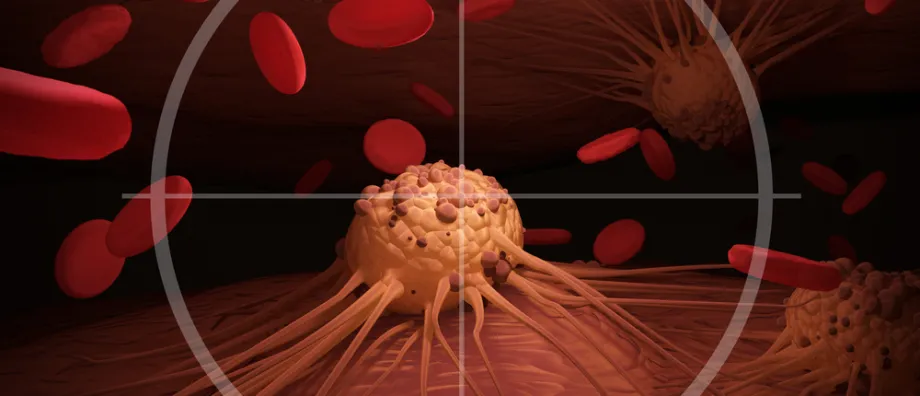
Graphic by AuntSpray, Shutterstock.
Stanford News - June 16th, 2016 - by Amy Adams
There’s a good, bad and ugly to cancer chemotherapy. The good is that the drugs do often effectively kill cancer cells. The bad is that the drugs also damage other quickly dividing cells in the body, causing side effects ranging from cosmetic, like hair loss, to disabling.
The ugly occurs when the drug dose needed to kill a tumor is more than what a person’s body can handle. This might happen if the tumor doesn’t have much of a blood supply and very little of the drug, which is delivered through the bloodstream, can get in. A dose high enough to infiltrate the tumor could be deadly to other cells in the body. Some recently approved therapies get around this problem using antibodies to deliver a drug directly to tumors, bypassing healthy cells and possibly overcoming some of the uglier aspects of cancer chemotherapy.
Now Jennifer Cochran, associate professor of bioengineering, has built on this antibody approach using an engineered protein rather than an antibody to direct the drug to the tumor. Although the two techniques are conceptually similar, the specialized protein has the potential advantage of being able to pass through the barrier that protects the brain, thereby being able to treat brain tumors. It is also smaller than the antibody and might be able to reach dense tumors with little blood supply.

Photo by Diana Barbatti: Jennifer Cochran, associate
professor of bioengineering, is using an engineered
protein to direct chemotherapy drugs to cancer cells
while sparing healthy ones.
“Antibodies can be limited for treating solid tumors because they are too big to penetrate well,” Cochran said. “The idea is that a smaller molecule could diffuse into the tumor better.”
The work was published in a series of papers in the June issue of Molecular Cancer Therapeutics and the June 15 issue of Angewandte Chemie.
Targeting cancer
Cochran’s idea originated with the knowledge that cancer cells, and the blood supply that feeds them, often produce particular molecules known as integrins on their surface. The goal of her team was to create an engineered protein that could latch tightly onto those integrins and be used as a drug delivery vehicle.
First, the team needed to engineer a protein to bind integrins. Cochran employed a technique called directed evolution to rapidly engineer millions of proteins and screen for the qualities she’s interested in. In this case, they started with a protein called knottin – so named for its knot-like shape – and used directed evolution to engineer a protein variant that would bind strongly to integrins.
The researchers then worked on two strategies for attaching chemotherapeutic drugs to the evolved knottin. One strategy, carried out in collaboration with Sutro Biopharma, and led by postdoctoral fellow Nicolas Currier and bioengineering graduate student Shelley Ackerman, used a portion of an antibody to connect the drug to the knottin, mimicking antibody therapies that are already on the market – perhaps speeding the time it would take to get this therapy approved for patients. The team tested this approach in a lab dish and in mice with implanted human tumors and in each case the knottin successfully delivered the drug to the tumor and killed the cancer cells.
A second approach, developed in collaboration with postdoctoral fellow Nick Cox in the Stanford ChEM-H Medicinal Chemistry Knowledge Center, used a small chemical link to attach a chemotherapeutic drug directly to the knottin. The knottin-drug combination effectively killed breast, ovarian and pancreatic cancer cells in a lab dish. The targeted drug delivery was highly effective against cancer cells, including those that had developed a resistance to the drug alone.
“We found that when the drug was delivered by the knottin, its potency was greatly enhanced in treating highly resistant tumor cells, like those found in pancreatic cancer,” Cox said.
In both examples, the knottin portion of these multipart compounds binds to integrins present at high levels on cancer cells, delivering the drug directly into the cancer cell and bypassing healthy cells. Once inside, the drug is released and kills the cell. Because the drug is less active when connected to the knottin and cannot get inside cells of the body that do not express integrins, this approach could significantly reduce side effects on other tissues and organs.
Building on the past
This isn’t the first time Cochran has taken advantage of knottin’s affection for cancer cells. In previous work her team had attached the engineered knottin to a fluorescent dye that was visible by molecular imaging techniques. This dye-labeled knottin could seek out and attach to cancer cells in the brain and elsewhere in the body and make them visible to doctors, who often have a hard time detecting whether drugs are shrinking tumors.
That previous work gave Cochran and her team some useful information. First, they learned that the knottin can get past a barrier that protects the brain from many molecules. And second, they learned that the knottin does seek out cancer cells compared to healthy tissue. If it didn’t, the imaging signal would show a blur of light rather than visibly highlighting tumors.
“We’ve shown that these knottins can pass the blood-tumor barrier so the hope is that we can use this to deliver chemotherapy to brain tumors,” Cochran said.
Cochran is collaborating with Michelle Monje, assistant professor of neurology, and Gerald Grant, associate professor of neurosurgery, with the support of seed grants from Stanford Bio-X and the Stanford Child Health Research Institute to test this approach on childhood brain tumors.
These two knottin-based therapies are a first step. “These studies showed that we could use these molecules to deliver drugs to tumors,” Cochran said. “What we still need to understand is which cancers it works best on and what is the best chemotherapeutic drug to use.”
She and her team are also still exploring which of the two approaches will be most effective. The larger protein-drug combination might not work its way into dense tumors, for example, but will remain longer in the body and thus might deliver more benefits over time. The smaller compound could penetrate more effectively into tumors but will be cleared quickly from the bloodstream, possibly reducing its effectiveness.
Cochran is a professor of bioengineering and, by courtesy, of chemical engineering. She is also a member of Stanford Bio-X, the Child Health Research Institute, the Stanford Cancer Institute, Stanford ChEM-H and the Stanford Neurosciences Institute.
The work was supported by the National Institutes of Health, the Stanford Child Health Research Institute, Stanford Bio-X, Stanford ChEM-H, the National Science Foundation, the Stanford Department of Bioengineering and the Anne T. and Robert M. Bass Endowed Fellowship in Pediatric Cancer and Blood Diseases.



